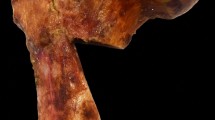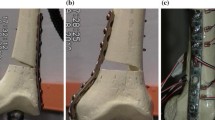Abstract
Purpose
The purpose of our study was to determine the biomechanical properties of three different implants utilized for internal fixation of a supracondylar femur fracture. The retrograde supracondylar nail (SCN), the less invasive stabilization system plate (LISS) and the distal femoral nail (DFN) were tested and their biomechanical properties compared.
Methods
Twenty pairs of fresh-frozen human femura were used. Each femur was osteotomised to simulate a comminuted supracondylar fracture (AO/OTA 33.A3) and then randomized to fracture fixation with either SCN (n=9) or LISS (n=9). Each contralateral femur was stabilized with DFN as a control (n=18). Two femur pairs were spent on pretesting. All femura were subjected to axial (10–500 N) and torsional (0.1–14 Nm) loading.
Results
Eighteen matched femur pairs were analyzed. The post-loading median residual values were 49.78, 41.25 and 33.51% of the axial stiffness of the intact femur and 59.04, 62.37 and 46.72% of the torsional stiffness of the intact femur in the SCN, LISS and DFN groups. There were no significant differences between the three implants concerning axial and torsional stiffness.
Conclusions
All implants had sufficient biomechanical stability under physiological torsional and axial loading. All three implants have different mechanisms for distal locking. The SCN nail with the four-screw distal interlocking had the best combined axial and torsional stiffness whereas the LISS plate had the highest torsional stiffness.






Similar content being viewed by others
References
Arneson TJ, Melton LJ 3rd, Lewallen DG, et al. Epidemiology of diaphyseal and distal femoral fractures in Rochester, Minnesota, 1965–1984. Clin Orthop Relat Res. 1988;234:188–94.
Bell KM, Johnstone AJ, Court-Brown CM, et al. Primary knee arthroplasty for distal femoral fractures in elderly patients. J Bone Jt Surg Br. 1992;74:400–2.
Dávid A. Distale Femurfrakturen. Orthopädie und Unfallchirurgie up2date. 2006;1:9–32.
David SM, Harrow ME, Peindl RD, et al. Comparative biomechanical analysis of supracondylar femur fracture fixation: locked intramedullary nail versus 95-degree angled plate. J Orthop Trauma. 1997;11:344–50.
Dunlop DG, Brenkel IJ. The supracondylar intramedullary nail in elderly patients with distal femoral fractures. Injury. 1999;30:475–84.
El-Kawy S, Ansara S, Moftah A, et al. Retrograde femoral nailing in elderly patients with supracondylar fracture femur; is it the answer for a clinical problem? Int Orthop. 2007;31:83–6.
Gellman RE, Paiement GD, Green HD, et al. Treatment of supracondylar femoral fractures with a retrograde intramedullary nail. Clin Orthop Relat Res. 1996;332:90–7.
Grass R, Biewener A, Rammelt S, et al. Retrograde locking nail osteosynthesis of distal femoral fractures with the distal femoral nail (DFN). Der Unfallchirurg. 2002;105:298–314.
Heiney JP, Barnett MD, Vrabec GA, et al. Distal femoral fixation: a biomechanical comparison of trigen retrograde intramedullary (i.m.) nail, dynamic condylar screw (DCS), and locking compression plate (LCP) condylar plate. J Trauma. 2009;66:443–9.
Ito K, Hungerbuhler R, Wahl D, et al. Improved intramedullary nail interlocking in osteoporotic bone. J Orthop Trauma. 2001;15:192–6.
Janzing HM, Stockman B, Van Damme G, et al. The retrograde intramedullary nail: prospective experience in patients older than sixty-five years. J Orthop Trauma. 1998;12:330–3.
Kanabar P, Kumar V, Owen PJ, et al. Less invasive stabilisation system plating for distal femoral fractures. J Orthop Surg (Hong Kong). 2007;15:299–302.
Kolmert L, Wulff K. Epidemiology and treatment of distal femoral fractures in adults. Acta Orthop Scand. 1982;53:957–62.
Kregor PJ, Perren SM. Evolution of fracture care of distal femoral fractures. Injury. 2001;32(Suppl 3):SC1–2.
Krettek C, Schandelmaier P, Tscherne H. New developments in stabilization of dia- and metaphyseal fractures of long tubular bones. Der Orthopade. 1997;26:408–21.
Kumar A, Jasani V, Butt MS. Management of distal femoral fractures in elderly patients using retrograde titanium supracondylar nails. Injury. 2000;31:169–73.
Marti A, Fankhauser C, Frenk A, et al. Biomechanical evaluation of the less invasive stabilization system for the internal fixation of distal femur fractures. J Orthop Trauma. 2001;15:482–7.
Martinet O, Cordey J, Harder Y, et al. The epidemiology of fractures of the distal femur. Injury. 2000;31(Suppl 3):C62–3.
Meyer RW, Plaxton NA, Postak PD, et al. Mechanical comparison of a distal femoral side plate and a retrograde intramedullary nail. J Orthop Trauma. 2000;14:398–404.
Michel M (1993) In vivo load on a locked intramedullary nail in the human femur. MD Thesis, University of Bern.
Pfeil J, Hasch E. Transposition osteotomy on the knee joint. Z Orthop Ihre Grenzgeb. 2005;143:R43–64.
Schandelmaier P, Partenheimer A, Koenemann B, et al. Distal femoral fractures and LISS stabilization. Injury. 2001;32(Suppl 3):SC55–63.
Schutz M, Muller M, Regazzoni P, et al. Use of the less invasive stabilization system (LISS) in patients with distal femoral (AO33) fractures: a prospective multicenter study. Arch Orthop Trauma Surg. 2005;125:102–8.
Sears BR, Ostrum RF, Litsky AS. A mechanical study of gap motion in cadaveric femurs using short and long supracondylar nails. J Orthop Trauma. 2004;18:354–60.
Seifert J, Stengel D, Matthes G, et al. Retrograde fixation of distal femoral fractures: results using a new nail system. J Orthop Trauma. 2003;17:488–95.
Taylor SJ, Walker PS. Forces and moments telemetered from two distal femoral replacements during various activities. J Biomech. 2001;34:839–48.
Wahnert D, Hoffmeier KL, Von Oldenburg G, et al. Internal fixation of type-C distal femoral fractures in osteoporotic bone. J Bone Jt Surg Am. 2010;92:1442–52.
Wick M, Muller EJ, Kutscha-Lissberg F, et al. Periprosthetic supracondylar femoral fractures: LISS or retrograde intramedullary nailing? Problems with the use of minimally invasive technique. Der Unfallchirurg. 2004;107:181–8.
Wild M, Thelen S, Spoor V, et al. Do locked compression intramedullary nails improve the biomechanical stability of distal femoral fractures? J Trauma. 2011;70:832–7.
Zlowodzki M, Bhandari M, Marek DJ, et al. Operative treatment of acute distal femur fractures: systematic review of 2 comparative studies and 45 case series (1989 to 2005). J Orthop Trauma. 2006;20:366–71.
Zlowodzki M, Williamson S, Cole PA, et al. Biomechanical evaluation of the less invasive stabilization system, angled blade plate, and retrograde intramedullary nail for the internal fixation of distal femur fractures. J Orthop Trauma. 2004;18:494–502.
Acknowledgments
Supported in part by Stryker Trauma GmbH, Kiel, Germany. The devices used in this study are approved by the FDA, International and German Medical Devices Authority.
Conflict of interest
On behalf of all authors, the corresponding author states that there is no conflict of interest.
Author information
Authors and Affiliations
Corresponding author
Rights and permissions
About this article
Cite this article
Mehling, I., Hoehle, P., Sternstein, W. et al. Nailing versus plating for comminuted fractures of the distal femur: a comparative biomechanical in vitro study of three implants. Eur J Trauma Emerg Surg 39, 139–146 (2013). https://doi.org/10.1007/s00068-012-0247-1
Received:
Accepted:
Published:
Issue Date:
DOI: https://doi.org/10.1007/s00068-012-0247-1




